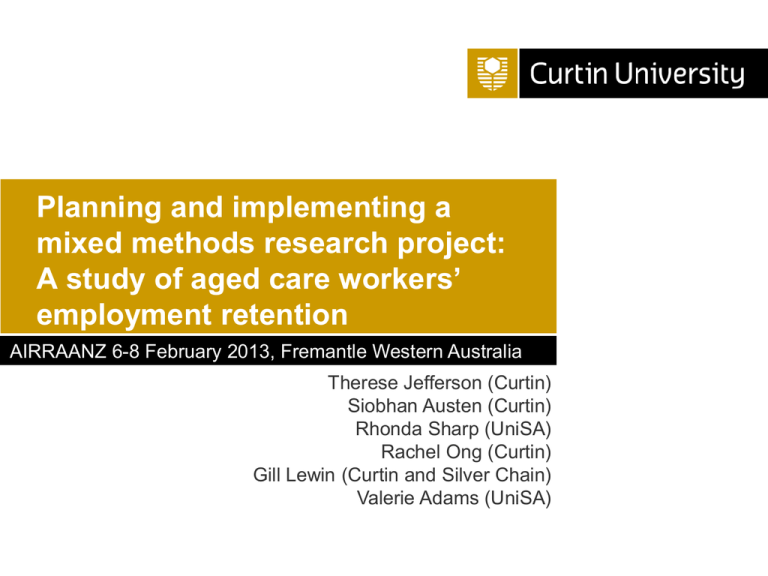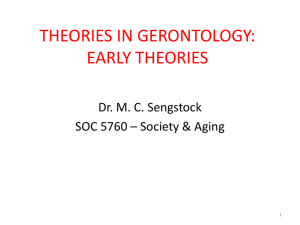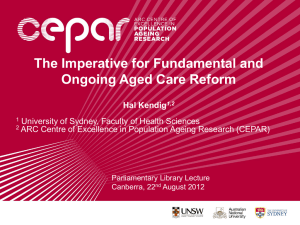`Planning and implementing a mixed methods research project: A
advertisement

Planning and implementing a mixed methods research project: A study of aged care workers’ employment retention AIRRAANZ 6-8 February 2013, Fremantle Western Australia Therese Jefferson (Curtin) Siobhan Austen (Curtin) Rhonda Sharp (UniSA) Rachel Ong (Curtin) Gill Lewin (Curtin and Silver Chain) Valerie Adams (UniSA) Objectives Policy context and rationale for the study The research team Research design and proposal Challenges with implementation Modifications consistent with research objectives Lessons learned So what? Policy context and rationale for the study Project title: Missing workers: retaining mature age women workers to ensure future labour security Projected rise in demand of 325% for aged care workers between 2003 and 2031(Hugo 2007) Women > 90% of aged care workforce Median age of workforce is 45+ Number of aged care nurses declined 22.3%, 1986 – 2001 Little economic theory/analysis of labour supply of mature age women The research team Multidisciplinary Backgrounds and/or strong interest in feminist economics Limits of orthodox approaches to labour supply analysis Collaborative group – but a new group Research design and proposal Aims: Identify factors that promote or hinder mature age women’s retention in paid work Develop model of employment decision making relevant to mature age women’s circumstances Contribute to policy frameworks relevant to employment security in the aged care sector Research design and proposal Constraints Need for innovation Match our skill sets/track records Contribute to theory Provide national benefits Desirable International comparisons Existing survey instruments Research design and proposal Specific research questions 1. What are the key economic, social and demographic characteristics associated with mature age women who decide to maintain or leave employment in Australia’s aged care sector? 2. How do mature age women workers describe their experiences and perceptions of work and reasons for staying or considering exit from Australia’s aged care sector? Research design and proposal Specific research questions 3. What do the findings from 1 and 2 suggest for economic theory and policy relevant to the attraction and retention of mature age women workers in Australia’s aged care sector? Research design and proposal Question 1: Measure the significance of possible causal relationships between characteristics and stay/exit Question 2: Experiences and perceptions – not for measurement Research design and proposal Research design (proposed) Embedded mixed methods – Explanatory and Sequential (Cresswell and Plano Clark 2007) Priority given to quantitative data/analysis with a longitudinal design Qualitative data/analysis embedded within context of large scale quant study Research design and proposal Data sources 1. Pilot study, 14 semi structured interviews (informed research proposal) 2. Silver Chain staff records (anonymised) 3. HILDA survey 4. Modified NEXT survey – 2 rounds 5. 50 semi structured interviews with sample from NEXT survey participants Research design (proposal) – NEXT and interviews National survey 1 intentions – data collection and analysis n = 7,000 Semi structured interviews – based on analysis of survey (n=70) Compare/contrast integrate findings National survey 2 intentions – data collection and analysis (n=?) Implications Policy and Theory Challenges with implementation 1. Funding 2. Distribution of survey – coordinating with participants 3. Data input of Survey 1(4,000 responses) 4. Analytical requirements/publication 5. Commencement of interviews 6. Data collection – Survey 2 Research design (modified) National survey 1 intentions – data collection n = 4,000 Compare/contrast integrate findings National survey 1 intentions – limited data analysis n = 4,000 National survey 2 – data collection (n=2,200) National surveys 1 and 2 analysis Semi structured interview schedule using content of survey 1 instrument=50 Semi-structured interview data collection and analysis Implications Policy and Theory Research design modified 1. Need for consistency with research objectives and questions 2. Initial design of interview schedule based on content of Survey 1 instrument rather than analysis 3. Iterative process of qual data collection/analysis – modifications to interview schedule 4. Iterative process of Survey 1 analysis, qual analysis/collection and Survey 2 design/analysis 5. Analysis not complete – more challenges likely Lessons learned – research design/process Iterative processes within a sequential design Insights from qualitative data beyond illustration and causal direction – pay/recognition Opportunity for ‘emergent themes’ in qualitative component – need for dual analytical approach (CALD) Flexibility in design – exploratory data analysis rather than singular focus on hypothesis testing (informal care roles and retention) Exploration –statistically non-significant relationships Longitudinal – opportunity for survey refinement So what? Implications for future large scale proposals and projects Unforeseen challenges Evolutionary nature of the process Time constraints - implications for sequential design Integration of quant and qual data at point of data collection rather than post – analysis Iterative process – need for close/frequent communication between research team members So what? Implications for future large scale proposals and projects Unanticipated benefits Flexibility of design – scope for exploration Capacity to investigate ‘non significant’ relationships Opportunity for data sets to be used independently – not planned but likely to occur in publications Usefulness of pilot interview data











